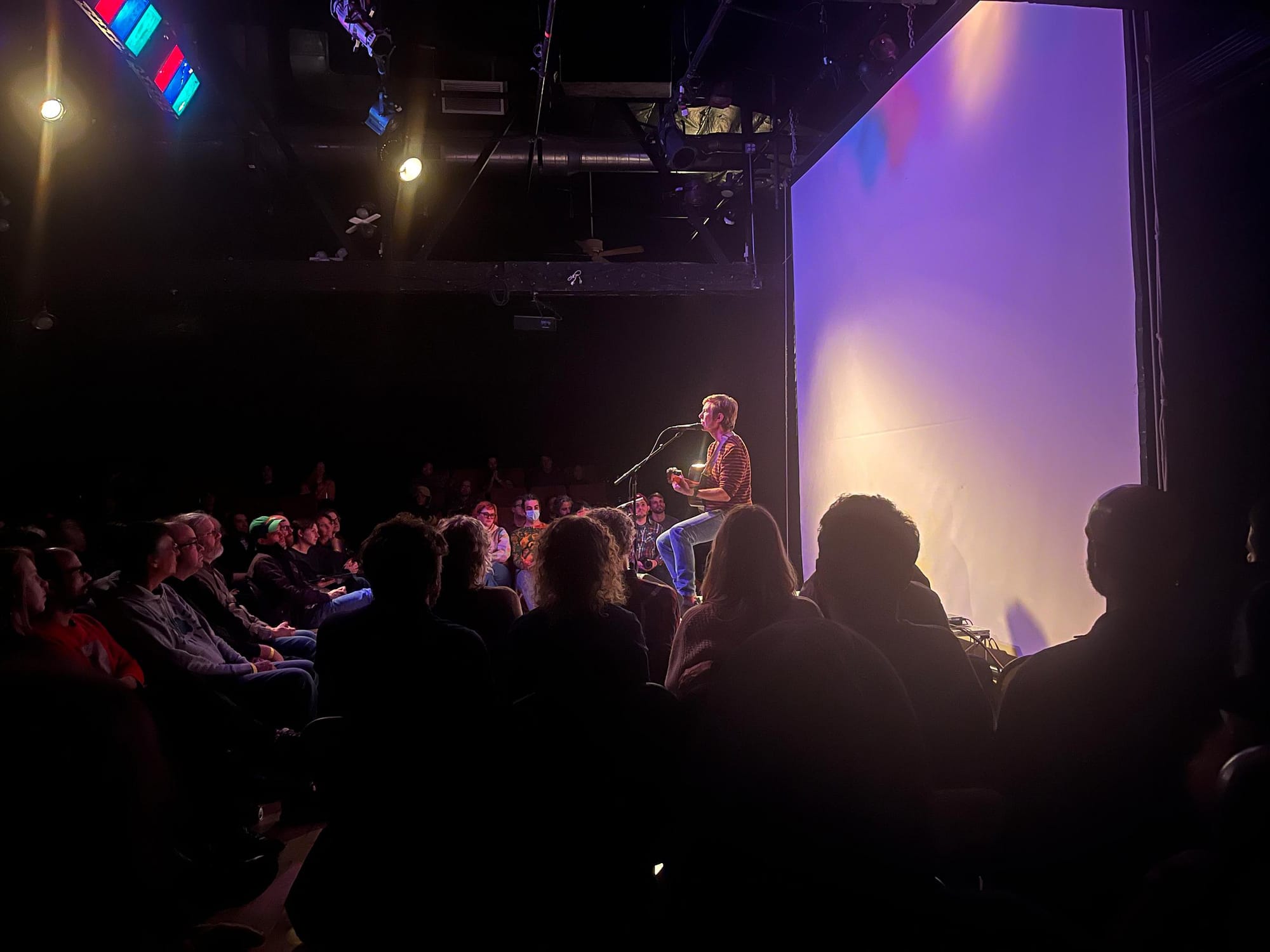Bill Callahan
The Constellation
Bricktown, Chicago
Dec. 5, 2023
“What’s up, Chicago?!” Bill Callahan enthusiastically inquired of his audience, denizens of his former hometown. “That’s what comedians say. I’ve been watching a lot of comedians lately.”
It showed. Callahan had yet to settle on his barstool perch and already seemed more at ease than is typically seen at a Bill Callahan concert.
Callahan, still tuning his nylon string acoustic guitar, his only instrument save for a singular drum pad and some droning loops, assured the Tuesday night audience at the Constellation, a small blackbox theater in the Bricktown neighborhood of Chicago, that this would be their home for the evening. “Feel free to keep your shoes on, get up, go grab a beer, go pee, who knows, I may have to pee. Or don’t do any of that,” he said slyly.
Callahan first released music under the name Smog in 1990 and grew into solo work. Over 23 albums he has run the gamut from lo-fi experimental musician to singer-songwriter, and was one of the first artists to sign with the Drag City label along with Pavement. The 2018 Netflix documentary Wild Wild Country was inspired by the chorus to his song “Drover” and features his songs heavily. In short, Callahan has a long track record, and in Tuesday’s truly special two-and-one-half-hour solo show — an acoustic performance aptly billed “An Evening with Bill Callahan” — he spanned it all.
The first portion of the evening saw primarily new material with some new, as-yet-unrecorded songs, including a Townes Van Zandt-eque storytelling ballad of riding in a trailer with a gorilla named Sugar Lee.
The room was exquisitely quiet, so quiet that even a straw questing for the final drops of a cocktail felt like auxiliary percussion. Callahan masterfully used this silence to showcase the power of negative space in his expanded acoustic interpretations of his work, letting notes rise and fall back into the silence before summoning another swell of arpeggiated notes. Many songs that on his albums were straightforward, driving tunes became meditative, plaintive strolls through a bucolic soundscape. Oftentimes he would repeat single words, like “one” from “One Fine Morning,” uttering them like a koan or a prayer.
Rather than discrete songs, Callahan’s performance felt like a vast, connected tapestry of stories told over acoustic guitar, with digressions, musical and conversational, and Callahan’s sparse banter, often jokes, helping connect each sonic idea. The comedy mentioned at the outset of his performance proved a central theme for the evening, as his lyrics were often wry observations and small relatable moments: “More and more / The horse walks into the house through the front door / More and more.” Besides creating a comical picture (Mr. Ed, is that you?), it also played with the mouth feel of the words themselves; Callahan played with his lyrics as much as he wrote them.
Unbothered by the historical chord structure of his songs, Callahan expanded and contracted, sped up or slowed down, and shifted keys in a way that asked the audience to interrogate whether it was all intentional or simply a side effect of a long career. Callahan himself, after a particularly ethereal rendition of “Drover,” said that “there’s no such things as a cappella songs, only songs people forget the chords to.”
The audience was a cross section of seemingly devout Callahan fandom, seated alternately in tiny plastic folding chairs or cinematically plush chairs on risers, none more than 30 feet from the six-by-six-foot makeshift stage. You really could hear every jangle of keys, knocked over beer bottle, and hushed, worshipful whisper over the course of the near three hours spent together. When someone got up, Callahan occasionally took a leaf out of the standup comedy playbook to do some audience work, bantering with one man who giggled “like a laugh track from the sitcom M*A*S*H.”
The intimacy of the show was carried through in the “set break,” which was a brief slide show of pictures documenting his current four-city tour beginning in New York City, followed by Philadelphia, onto Chicago and Washington state thereafter. They ranged from blurry pictures of a tunnel on the way to Philadelphia (we took his word for it) to a close-up picture of a single almond he opted to photograph rather than consume; it had fallen on a stark, deep red table, and he assumed the table had a questionable past. “Doesn’t it have nice skin?… And the little hole?” he asked, pointing to the large picture of a nut projected on the screen behind him, contrasting with the cherry apple red table.
The evening concluded with two encore songs, collectively decided with the audience. Upon returning to the stage, Callahan asked the audience in a calm, sincere manner, “What do you want to hear?” With shouts of “In the Pines,” “Sycamore,” “Dress Sexy at my Funeral,” “Rock Bottom Riser,” “Let Me See the Colts,” and more, Callahan indicated interest or lack thereof with slight inclinations of his head. After a few moments of guitar tuning and staring determinedly off into the medium distance, Callahan chose. “The real people went away,” he sang unaccompanied, introducing crowd favorite “Drover,” the first track on his 2011 masterstroke Apocalypse, followed by “Jim Cain,” a beloved track from Apocalypse’s predecessor, 2009’s Sometimes I Wish I Were an Eagle.
Early in the set, Callahan spoke about how the beginning of his songwriting career was a vehicle for him to learn how to communicate with others and himself; he then briefly lamented how his feelings had inverted and he felt more comfortable with a guitar than with other people. It was thus a rare treat to really see the human being behind the guitar in all of his storytelling, the drover behind his cattle.





